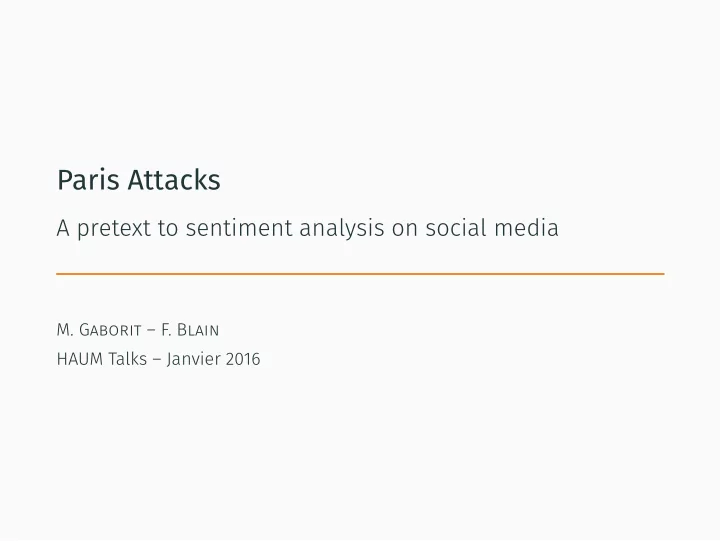

Paris Attacks A pretext to sentiment analysis on social media M. Gaborit – F. Blain HAUM Talks – Janvier 2016
Contents 1. Idea 2. Implementation 3. Hypothesis and Follow-up 4. What others do ? 2
Idea
A new type of reaction to events An event triggers a reaction which is public and spontaneous. 4
A new type of reaction to events An event triggers a reaction which is public and spontaneous. 4
Terrorist attacks on November 13 th Special for different reasons : • unexpected • lots of witnesses & victim 5 • impacting a young population • claimed after the strike
Terrosist attacks on November 13 th Reactions as important as the violence of the strikes : • huge amount of messages posted online (connected population) • wide range of reaction types Figure 1: Evolution of the number of tweets posted during the first hours after the strikes 6 • reaction of some people that spanned on several hours/days • heavy cell-phone usage to post ⇒ geotagged data
Proposition Is it possible to extract social characteristic times from the tweets posted after the terrorsit attacks ? Characteristic time : duration used to discriminate different events and/or evaluate their response velocity. 7
Proposition Is it possible to extract social characteristic times from the tweets posted after the terrorsit attacks ? Characteristic time : duration used to discriminate different events and/or evaluate their response velocity. 7
Why tweets ? • Short format • Easy to process • Writting with (almost) no thinking • Easy to fetch • Using the native MongoDB format • Efficient off-line processing • Possibility for several passes • Huge dataset to work with (several tenth of thousands...) 8 • Prone to clear and unambiguous reactions
Implementation
Planning 1. Fetch and store tweets for off-line analysis ( ParisAttacks ) 2. Language based auto-classification 3. Manual sentiment-based classification of a subset 4. Auto-classification using the classified subset as a training set 5. Propose observables to deduce social characteristic times 1 2 3 4 5 Website for human classif. Partial publication to challenge pertinence enjoy ! 10
Hypothesis and Follow-up
Hypothesis Long-term Reactions Unambiguous After-claim turn-around 12
Hypothesis Long-term Reactions To be verified checking the ratio of accounts with long-term reactions Unambiguous Non dumb hypothesis in a post-traumatic context, sustained by the short format After-claim turn-around To be verified after analysis... may be we’ll need to exclude Daech oriented tweets 12
Follow-ups • Use geo-tagging to enhance analysis • Compare with other public events (sports, political sutff, etc...) • medias • politics • others... 13 • Correlate results with papers/news publication • Per-channel analysis :
Follow-ups • Compare with CharlieHebdo events in January 2015 (coupled reaction hypothesis) • Explore self-organization modes (PorteOuverte , I’m Safe ) • Self-emulation or response to a stimulus (tweet of a political persron, a media) • Bi-varying analysis 13 Sentiment #Tweets
About stats • Non representative population sample • First reactions biased by media annonces (a media always has an opinion) • Induced bias from the manual classification • etc... 14
What others do ?
What others do ? Michal Lukasik, Trevor Cohn, and Kalina Bontcheva. Classifying Tweet Level Judgements of Rumours in Social Media. In Proceedings of EMNLP , volume 796, pages 2590–2595, 2015. Michal Lukasik, Trevor Cohn, and Kalina Bontcheva. Modeling Tweet Arrival Times using Log-Gaussian Cox Processes. In Proceedings of EMNLP , volume 796, pages 250–255, 2015. Laurent Luce. Twitter sentiment analysis using Python and NLTK. Oriane Piquer-Louis. Documenter l’expérience habitante de la ville sur les réseaux sociaux : corpus photographiques et données numériques, le sens des collections. 16
Thank you ! Questions ? fred@haum.org — mathieu@haum.org 17
Recommend
More recommend